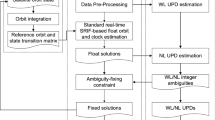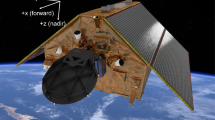Abstract
The Sentinel-3 mission takes routine measurements of sea surface heights and depends crucially on accurate and precise knowledge of the spacecraft. Orbit determination with a targeted uncertainty of less than 2 cm in radial direction is supported through an onboard Global Positioning System (GPS) receiver, a Doppler Orbitography and Radiopositioning Integrated by Satellite instrument, and a complementary laser retroreflector for satellite laser ranging. Within this study, the potential of ambiguity fixing for GPS-only precise orbit determination (POD) of the Sentinel-3 spacecraft is assessed. A refined strategy for carrier phase generation out of low-level measurements is employed to cope with half-cycle ambiguities in the tracking of the Sentinel-3 GPS receiver that have so far inhibited ambiguity-fixed POD solutions. Rather than explicitly fixing double-difference phase ambiguities with respect to a network of terrestrial reference stations, a single-receiver ambiguity resolution concept is employed that builds on dedicated GPS orbit, clock, and wide-lane bias products provided by the CNES/CLS (Centre National d’Études Spatiales/Collecte Localisation Satellites) analysis center of the International GNSS Service. Compared to float ambiguity solutions, a notably improved precision can be inferred from laser ranging residuals. These decrease from roughly 9 mm down to 5 mm standard deviation for high-grade stations on average over low and high elevations. Furthermore, the ambiguity-fixed orbits offer a substantially improved cross-track accuracy and help to identify lateral offsets in the GPS antenna or center-of-mass (CoM) location. With respect to altimetry, the improved orbit precision also benefits the global consistency of sea surface measurements. However, modeling of the absolute height continues to rely on proper dynamical models for the spacecraft motion as well as ground calibrations for the relative position of the altimeter reference point and the CoM.








Similar content being viewed by others
References
Allende-Alba G, Montenbruck O (2016) Robust and precise baseline determination of distributed spacecraft in LEO. Adv Space Res 57(1):46–63. https://doi.org/10.1016/j.asr.2015.09.034
Aschbacher J, Milagro-Pérez MP (2012) The European Earth monitoring (GMES) programme: status and perspectives. Remote Sens Environ 120:3–8. https://doi.org/10.1016/j.rse.2011.08.028
Auriol A, Tourain C (2010) DORIS system: the new age. Adv Space Res 46(12):1484–1496. https://doi.org/10.1016/j.asr.2010.05.015
Bertiger WI, Bar-Sever YE, Christensen EJ, Davis ES, Guinn JR, Haines BJ, Ibanez-Meier RW, Jee JR, Lichten SM, Melbourne WG, Muellerschoen RJ, Munson TN, Vigue Y, Wu SC, Yunck TP, Schutz BE, Abusali PAM, Rim HJ, Watkins MM, Willis P (1994) GPS precise tracking of TOPEX/POSEIDON: results and implications. J Geophys Res Oceans 99(12):24,449–24,464. https://doi.org/10.1029/94JC01171
Bertiger W, Desai SD, Haines B, Harvey N, Moore AW, Owen S, Weiss JP (2010) Single receiver phase ambiguity resolution with GPS data. J Geod 84(5):327–337. https://doi.org/10.1007/s00190-010-0371-9
Betz J (2016) Engineering satellite-based navigation and timing–global navigation satellite systems, signals, and receivers. Wiley-IEEE Press, New York
Bock H, Jäggi A, Beutler G, Meyer U (2014) GOCE: precise orbit determination for the entire mission. J Geod 88(11):1047–1060. https://doi.org/10.1007/s00190-014-0742-8
Cerri L, Berthias J, Bertiger W, Haines B, Lemoine F, Mercier F, Ries J, Willis P, Zelensky N, Ziebart M (2010) Precision orbit determination standards for the Jason series of altimeter missions. Marine Geod 33(S1):379–418. https://doi.org/10.1080/01490419.2010.488966
Doornbos E (2012) Thermospheric density and wind determination from satellite dynamics. Springer, Heidelberg
Eanes RJ, Bettadpur S (1996) The CSR 3.0 global ocean tide model: diurnal and semi-diurnal ocean tides from TOPEX/POSEIDON altimetry, CSR-TM-96-05, University of Texas at Austin
Fernández J, Fernández C, Féménias P, Peter H (2016) The Copernicus Sentinel-3 mission. In: ILRS workshop 2016, ILRS, pp 1–4
Fernández Martìn C (2016) Sentinel-3A properties for GPS POD, GMV-GMESPOD-TN-0027, v1.2
Fernández Martìn C (2017) RINEX generation strategies for Sentinel, GMV-GMESPOD-TN-0030, v1.2
Fletcher K (ed) (2012) Sentinel-3 -ESA’s global land and ocean mission for GMES operational services. ESA, Noordwijk
Flohrer C, Otten M, Springer T, Dow J (2011) Generating precise and homogeneous orbits for Jason-1 and Jason-2. Adv Space Res 48(1):152–172. https://doi.org/10.1016/j.asr.2011.02.017
Hackel S, Montenbruck O, Steigenberger P, Balss U, Gisinger C, Eineder M (2016) Model improvements and validation of TerraSAR-X precise orbit determination. J Geod 91(5):547–562. https://doi.org/10.1007/s00190-016-0982-x
Hauschild A (2017) Basic observation equations. In: Teunissen P, Montenbruck O (eds) Springer handbook of global navigation satellite systems, chap 19. Springer, Heidelberg, pp 561–582
Hofmann-Wellenhof B, Lichtenegger H, Wasle E (2007) GNSS—Global Navigation Satellite Systems: GPS, GLONASS, Galileo, and more. Springer, Wien
IGS RINEX WG, RTCM-SC104 (2015) RINEX - the receiver independent exchange format, v. 3.03
Jäggi A, Hugentobler U, Bock H, Beutler G (2007) Precise orbit determination for GRACE using undifferenced or doubly differenced GPS data. Adv Space Res 39(10):1612–1619. https://doi.org/10.1016/j.asr.2007.03.012
Jäggi A, Dach R, Montenbruck O, Hugentobler U, Bock H, Beutler G (2009) Phase center modeling for LEO GPS receiver antennas and its impact on precise orbit determination. J Geod 83(12):1145–1162. https://doi.org/10.1007/s00190-009-0333-2
Jäggi A, Dahle C, Arnold D, Bock H, Meyer U, Beutler G, van den IJssel J (2016) Swarm kinematic orbits and gravity fields from 18 months of GPS data. Adv Space Res 57(1):218–233. https://doi.org/10.1016/j.asr.2015.10.035
Knocke PC, Ries JC, Tapley BD (1988) Earth radiation pressure effects on satellites. In: AIAA/AAS astrodynamics conference, pp 577–587
Laurichesse D, Mercier F, Berthias JP, Broca P, Cerri L (2009) Integer ambiguity resolution on undifferenced GPS phase measurements and its application to PPP and satellite precise orbit determination. Navigation 56(2):135–149. https://doi.org/10.1002/j.2161-4296.2009.tb01750.x
Le Roy Y, Deschaux-Beaume M, Mavrocordatos C, Aguirre M, Heliere F (2007) SRAL SAR radar altimeter for Sentinel-3 mission. In: International geoscience and remote sensing symposium, IGARSS 2007, pp 219–222
Loyer S, Perosanz F, Mercier F, Capdeville H, Marty JC (2012) Zero-difference GPS ambiguity resolution at CNES-CLS IGS analysis center. J Geod 86(11):991. https://doi.org/10.1007/s00190-012-0559-2
Luthcke S, Zelensky N, Rowlands D, Lemoine F, Williams T (2003) The 1-centimeter orbit: Jason-1 precision orbit determination using GPS, SLR, DORIS, and altimeter data special issue: Jason-1 calibration/validation. Marine Geod 26(3–4):399–421. https://doi.org/10.1080/714044529
Mayer-Gürr T, Pail R, Schuh WD, Kusche J, Baur O, Jäggi A (2012) The new combined satellite only model GOCO03s. In: International symposium on gravity, geoid and height systems, Venice, Italy
Meindl M, Beutler G, Thaller D, Dach R, Jäggi A (2013) Geocenter coordinates estimated from GNSS data as viewed by perturbation theory. Adv Space Res 51(7):1047–1064. https://doi.org/10.1016/j.asr.2012.10.026
Melbourne W (1985) The case for ranging in GPS based geodetic systems. In: Goad C (ed) Proceedings of the 1st international symposium on precise positioning with the Global Positioning System, NOAA, pp 373–386
Mendes V, Pavlis E (2004) High-accuracy zenith delay prediction at optical wavelengths. Geophys Res Lett 31(14):L14,602. https://doi.org/10.1029/2004GL020308
Milani A, Nobili AM, Farinella P (1987) Non-gravitational perturbations and satellite geodesy. Adam Hilger, Bristol
Misra P, Enge P (2006) Global Positioning System: signals, measurements and performance, 2nd edn. Ganga-Jamuna Press, MA
Montenbruck O, Neubert R (2011) Range correction for the Cryosat and GOCE laser retroreflector arrays, DLR/GSOC TN 11-01. https://ilrs.cddis.eosdis.nasa.gov/docs/TN_1101_IPIE_LRA_v1.0.pdf
Montenbruck O, Van Helleputte T, Kroes R, Gill E (2005) Reduced dynamic orbit determination using GPS code and carrier measurements. Aerosp Sci Technol 9(3):261–271. https://doi.org/10.1016/j.ast.2005.01.003
Montenbruck O, Andres Y, Bock H, van Helleputte T, van den IJssel J, Loiselet M, Marquardt C, Silvestrin P, Visser P, Yoon Y (2008) Tracking and orbit determination performance of the GRAS instrument on MetOp-A. GPS Solut 12(4):289–299. https://doi.org/10.1007/s10291-008-0091-2
Öhgren M, Bonnedal M, Ingvarson P (2011) GNSS antenna for precise orbit determination including s/c interference predictions. In: Proceedings of the 5th European conference on antennas and propagation (EUCAP), pp 1990–1994
Pearlman MR, Degnan JJ, Bosworth J (2002) The international laser ranging service. Adv Space Res 30(2):135–143. https://doi.org/10.1016/S0273-1177(02)00277-6
Peter H, Jäggi A, Fernández J, Escobar D, Ayuga F, Arnold D, Wermuth M, Hackel S, Otten M, Simons W, Visser P, Hugentobler U, Féménias P (2017) Sentinel-1A—first precise orbit determination results. Adv Space Res. https://doi.org/10.1016/j.asr.2017.05.034
Picone JM, Hedin AE, Drob DP, Aikin AC (2002) NRLMSISE-00 empirical model of the atmosphere: statistical comparisons and scientific issues. J Geophys Res https://doi.org/10.1029/2002JA009430
Priestley KJ, Smith GL, Thomas S, Cooper D, Lee RB, Walikainen D, Hess P, Szewczyk ZP, Wilson R (2011) Radiometric performance of the CERES Earth radiation budget climate record sensors on the EOS Aqua and Terra spacecraft through April 2007. J Atmos Ocean Tech 28(1):3–21. https://doi.org/10.1175/2010JTECHA1521.1
Ray R (1999) A global ocean tide model from TOPEX/POSEIDON altimetry: GOT99.2, NASA technical memorandum 209478
Rebischung P (2012) IGb08: an update on IGS08, IGSMAIL-6663. https://igscb.jpl.nasa.gov/pipermail/igsmail/2012/007853.html
Rebischung P (2016) Upcoming switch to IGS14/igs14.atx, IGSMAIL-7399. https://igscb.jpl.nasa.gov/pipermail/igsmail/2016/008589.html
Rebischung P, Griffiths J, Ray J, Schmid R, Collilieux X, Garayt B (2012) IGS08: the IGS realization of ITRF2008. GPS Solut 16(4):483–494. https://doi.org/10.1007/s10291-011-0248-2
Schmid R, Dach R, Collilieux X, Jäggi A, Schmitz M, Dilssner F (2016) Absolute IGS antenna phase center model igs08. atx: status and potential improvements. J Geod 90(4):343–364. https://doi.org/10.1007/s00190-015-0876-3
Shampine LF, Gordon MK (1975) Computer solution of ordinary differential equations: the initial value problem. W. H. Freeman, San Francisco
Silvestrin P, Cooper J (2000) Method of processing of signals of a satellite positioning system, US patent 6157341
Sinander P, Silvestrin P (1997) The advanced GPS Glonass ASIC for spacecraft control and earth science applications. In: Proceedings of the data systems in aerospace—DASIA 97, ESA SP-409, vol 409, pp 287–294
Sutton EK (2009) Normalized force coefficients for satellites with elongated shapes. J Spacecr Rockets 46(1):112–116. https://doi.org/10.2514/1.40940
Švehla D, Rothacher M (2003) Kinematic and reduced-dynamic precise orbit determination of low earth orbiters. Adv Geosci 1:47–56. https://doi.org/10.5194/adgeo-1-47-2003
Swatschina P, Montenbruck O, Bock H, Jäggi A (2011) Accuracy assessment of GOCE orbit solutions. In: 4th International GOCE user workshop
Tapley B, Schutz B, Born GH (2004) Statistical orbit determination. Academic Press, London
Teunissen PJG (1995) The least-squares ambiguity decorrelation adjustment: a method for fast GPS integer ambiguity estimation. J Geod 70(1):65–82. https://doi.org/10.1007/BF00863419
van den IJssel J, Encarnação J, Doornbos E, Visser P (2015) Precise science orbits for the Swarm satellite constellation. Adv Space Res 56(6):1042–1055. https://doi.org/10.1016/j.asr.2015.06.002
van den IJssel J, Forte B, Montenbruck O (2016) Impact of Swarm GPS receiver updates on POD performance. Earth Planets Space 68(1):1–17. https://doi.org/10.1186/s40623-016-0459-4
Woo KT (2000) Optimum semicodeless carrier-phase tracking of L2. Navigation 47(2):82–99. https://doi.org/10.1002/j.2161-4296.2000.tb00204.x
Wu JT, Wu SC, Hajj G, Bertiger WI, Lichten SM (1993) Effects of antenna orientation on GPS carrier phase. Manuscr Geod 18(2):91–98
Wübbena G (1985) Software developments for geodetic positioning with GPS using TI 4100 code and carrier measurements. In: Goad C (ed) Proceedings of the 1st international symposium on precise positioning with the Global Positioning System, NOAA, pp 403–412
Xu G (2010) GPS—theory, algorithms, and applications, 2nd edn. Springer, Berlin
Acknowledgements
Sentinel-3 flight and pre-mission test data used in this study have kindly been made available by the European Commission (EC) and the European Space Agency (ESA) as part of the Copernicus program. We also appreciate the continued technical support received by GMV and the CPOD Quality Working Group within the frame of the Copernicus Precise Orbit Determination (CPOD) service. Our study builds extensively on GPS orbit, clock, and bias products facilitating ambiguity resolution, which are made available by the joint CNES/CLS (Centre National d’Études Spatiales / Collecte Localisation Satellites) analysis center of the International GNSS Service (IGS). Provision of this community service is greatly appreciated and acknowledged. The authors are, furthermore, grateful to the International Satellite Laser Ranging Service (ILRS) for their continued effort to collect and publicly provide the SLR observations of Sentinel-3A and other LEO satellites.
Author information
Authors and Affiliations
Corresponding author
Rights and permissions
About this article
Cite this article
Montenbruck, O., Hackel, S. & Jäggi, A. Precise orbit determination of the Sentinel-3A altimetry satellite using ambiguity-fixed GPS carrier phase observations. J Geod 92, 711–726 (2018). https://doi.org/10.1007/s00190-017-1090-2
Received:
Accepted:
Published:
Issue Date:
DOI: https://doi.org/10.1007/s00190-017-1090-2




